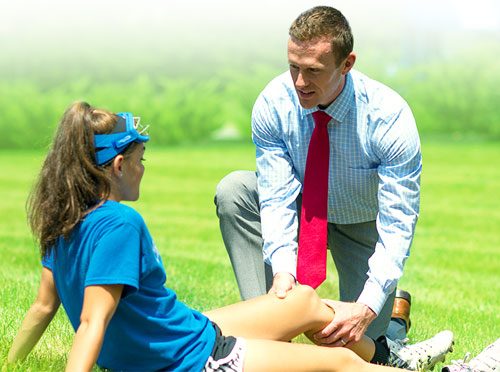Dr. Rice has joined Beacon Orthopedics and Sports Medicine
Congratulations Dr. Rice: 2025 Cincinnati Magazine Top Doctor
GLUTEUS MEDIUS / GLUTEUS MINIMUS TEAR (ABDUCTOR TEAR)
Hip abductors are a major group of muscles found in the buttocks. This group includes the gluteus maximus, gluteus medius, gluteus minimus, and tensor fascia lata muscles.
The Gluteus medius arises at the top of the pelvic bone and runs to attach on the outer side of the thighbone or femur. The muscle controls side-to-side movement of the hip and stabilizes hip movement.
The gluteus minimus arises from the outer surface of the ilium (part of the pelvic bone) and attaches to the front of the greater trochanter of the femur. It works alongside the gluteus medius to abduct and medially rotate the thigh, playing a crucial role in stabilizing the hip during walking and running.
A gluteus medius or gluteus minimus tear is a condition characterized by severe strain of these muscles, resulting in partial or complete rupture. It is also referred to as a rotator cuff tear of the hip.
Causes
The tear or rupture of the gluteus medius or gluteus minimus muscle is commonly seen in runners and athletes involved in high-impact sports such as soccer or basketball due to sudden bursts of activity or poor flexibility of the gluteus muscles. Any traumatic or overuse injury or degenerative changes may lead to partial or complete tear of these muscles.
Symptoms
The symptoms include pain and tenderness over the lateral aspect of the hip, which may aggravate with activities such as running, climbing stairs, prolonged sitting or walking, and lying on the affected side of the hip. One of the main symptoms of a gluteus medius or gluteus minimus tear is the presence of Trendelenburg sign - dropping of the pelvis towards the unaffected side due to the inability to bear weight on the affected limb.
Diagnosis
The diagnosis of a gluteus medius or gluteus minimus tear is based on physical examination of the patient, followed by palpation of the affected muscle, testing muscle power, and assessing the walking pattern or gait of the patient. Certain special tests such as the single-leg squat test or a positive Trendelenburg sign confirm the diagnosis. Sometimes, MRI or ultrasound may be helpful to show the pathological changes of the muscle.
Treatment
The aim of treatment is to restore the normal function of the gluteus medius or gluteus minimus tendon.
- Immediately following the rupture of the tendon, RICE therapy is advised, which involves:
- Rest: Refrain from activities until the hip is healed.
- Ice: Apply ice to the hip to reduce pain and inflammation caused by injury.
- Compression: Use an ACE bandage to reduce tenderness and swelling.
- Elevation: Keep the affected hip raised above your heart to minimize swelling.
- Medications such as non-steroidal anti-inflammatory drugs (NSAIDs) or steroid injections may be given to reduce pain and inflammation.
- Assistive devices such as a cane or crutch may be used temporarily to facilitate pain-free ambulation.
- Your surgeon may recommend physical therapy to strengthen the muscles and increase the stability of the hip.
- Surgical treatment may be recommended to repair a complete, full-thickness tear. The rupture can be repaired arthroscopically to help restore the strength and function of the gluteus medius or gluteus minimus.
Untreated cases of a gluteus medius or gluteus minimus tear may result in gait disturbance and disability.


